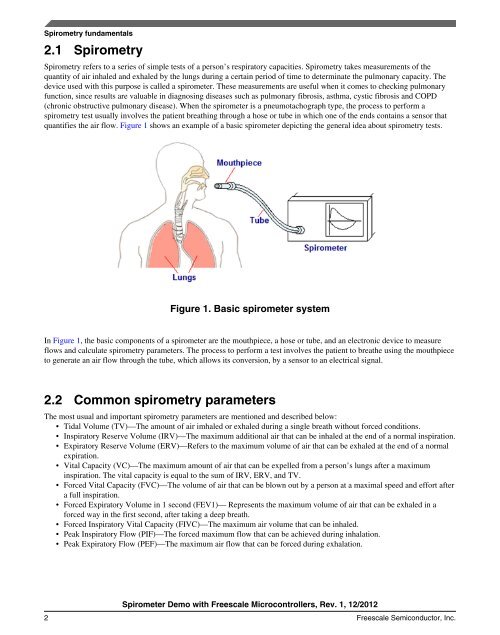Spirometer Demo with Freescale Microcontrollers
Spirometer Demo with Freescale Microcontrollers
Spirometer Demo with Freescale Microcontrollers
You also want an ePaper? Increase the reach of your titles
YUMPU automatically turns print PDFs into web optimized ePapers that Google loves.
Spirometry fundamentals<br />
2.1 Spirometry<br />
Spirometry refers to a series of simple tests of a person’s respiratory capacities. Spirometry takes measurements of the<br />
quantity of air inhaled and exhaled by the lungs during a certain period of time to determinate the pulmonary capacity. The<br />
device used <strong>with</strong> this purpose is called a spirometer. These measurements are useful when it comes to checking pulmonary<br />
function, since results are valuable in diagnosing diseases such as pulmonary fibrosis, asthma, cystic fibrosis and COPD<br />
(chronic obstructive pulmonary disease). When the spirometer is a pneumotachograph type, the process to perform a<br />
spirometry test usually involves the patient breathing through a hose or tube in which one of the ends contains a sensor that<br />
quantifies the air flow. Figure 1 shows an example of a basic spirometer depicting the general idea about spirometry tests.<br />
Figure 1. Basic spirometer system<br />
In Figure 1, the basic components of a spirometer are the mouthpiece, a hose or tube, and an electronic device to measure<br />
flows and calculate spirometry parameters. The process to perform a test involves the patient to breathe using the mouthpiece<br />
to generate an air flow through the tube, which allows its conversion, by a sensor to an electrical signal.<br />
2.2 Common spirometry parameters<br />
The most usual and important spirometry parameters are mentioned and described below:<br />
• Tidal Volume (TV)—The amount of air imhaled or exhaled during a single breath <strong>with</strong>out forced conditions.<br />
• Inspiratory Reserve Volume (IRV)—The maximum additional air that can be inhaled at the end of a normal inspiration.<br />
• Expiratory Reserve Volume (ERV)—Refers to the maximum volume of air that can be exhaled at the end of a normal<br />
expiration.<br />
• Vital Capacity (VC)—The maximum amount of air that can be expelled from a person’s lungs after a maximum<br />
inspiration. The vital capacity is equal to the sum of IRV, ERV, and TV.<br />
• Forced Vital Capacity (FVC)—The volume of air that can be blown out by a person at a maximal speed and effort after<br />
a full inspiration.<br />
• Forced Expiratory Volume in 1 second (FEV1)— Represents the maximum volume of air that can be exhaled in a<br />
forced way in the first second, after taking a deep breath.<br />
• Forced Inspiratory Vital Capacity (FIVC)—The maximum air volume that can be inhaled.<br />
• Peak Inspiratory Flow (PIF)—The forced maximum flow that can be achieved during inhalation.<br />
• Peak Expiratory Flow (PEF)—The maximum air flow that can be forced during exhalation.<br />
<strong>Spirometer</strong> <strong>Demo</strong> <strong>with</strong> <strong>Freescale</strong> <strong>Microcontrollers</strong>, Rev. 1, 12/2012<br />
2 <strong>Freescale</strong> Semiconductor, Inc.












